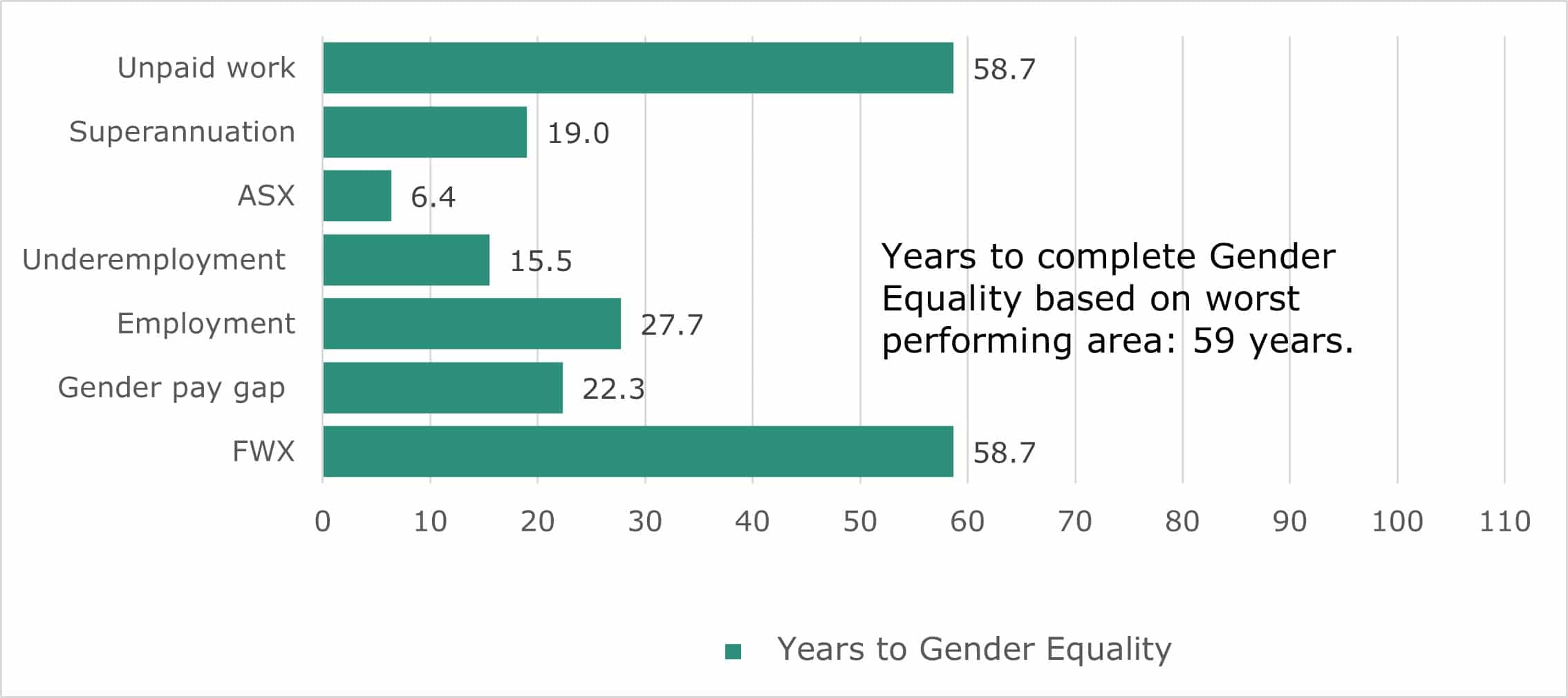Progress to gender financial equality reversed in the March quarter despite a significant win in super savings for women which saw the gender gap narrowing by the most in over a decade, according to the latest Financy Women’s Index (FWX).
The FWX, which you can download free here, is a quarterly measurement of the economic progress of women and timeframes to gender equality in Australia. The FWX provides a snapshot on gender equality across seven critical areas: education, employment, underemployment, wages, unpaid work, ASX 200 board gender diversity and superannuation.
The FWX headline result fell 1.6% to 72.2 points during the quarter, from 73.3 points in the December quarter. The result was weighed down by a deterioration in the FWX Underemployment sub-index, which measures the gender gap in the underemployment rate. It declined to 63 points from 71 points, as progress in the male underemployment rate improved faster than that of female. Overall, the time to full gender equality Is 59 years, which is the same as the previous quarter.
Year on year, the FWX is down 0.9%, taking some of the shine off a more progressive 2021 and recent jobs recovery.

“Australia’s economic recovery from the Covid-19 pandemic has been jobs-rich, for males and females,” said Jo Masters, chief economist, and partner at Barrenjoey Capital.
“The Financy Women’s Index captures this with the Employment sub-index improving in the March quarter. That’s good news but it’s offset by the decline in the Underemployment sub-index.
“Accessible and affordable childcare is crucial to supporting females to reach their full potential in the workforce,” she said.
The biggest improvement in the FWX occurred in the Superannuation sub-index, which gained as the underlying gender gap in median lifetime balances narrowed to 25%, from 31%, based on the latest figures from the Australian Bureau of Statistics (ABS).
The latest superannuation figures released by the ABS in April show that in the financial year to 30 June 2020, the median lifetime balance for women was $50,000 compared to $67,000 for men.
“This report highlights the improvements in the gender gap in superannuation balances at a critical time in our gender equality journey. Never before have women been more aware of the need to grow their own super, and this is being supported by organisational efforts as well. As a result, we have nearly halved the timeframe to equality in super to 19 years from 31 years,” said Bianca Hartge-Hazelman, author of the Financy Women’s Index.
But Ms Masters cautioned that it’s too early to celebrate. “19 years to close the gap in superannuation takes us to 2041! It means that we can’t afford to take our eye off the ball, we still need to be proactive with policy initiatives that help to drive this gap down,” she said.
The total time to gender equality in Australia stands at 59 years based on the worst performing area of progress, unpaid work, which has so far experienced a positive shift in gender dynamics during the pandemic.
The time to equality in the gender pay gap remains at a stable 22 years, whilst in employment it’s 28 years, down from 29 years, in underemployment it increased to 15.5 years, from 14 years and in ASX Boards it remains stable at 6.5 years.
“We’re heading in the right direction, but there’s still a lot of work,” said Dr Lili Sussman, Wisr, Chief Strategy Officer. “We need to run a lot faster, have more honest, deep conversations about the roles of women and men in an equal world, and put these discussions into action in as many ways as we can – the time to change is now.”
The narrowing of the superannuation gender gap appears to be the result of an improvement in the gender pay gap, paid and unpaid employment outcomes for women, and the unprecedented COVID-19 withdrawals under the Federal Liberal government’s Early Release Scheme in 2020.
Figures from the Australian Tax Office show that men accounted for 56% of the 5.5 million applicants compared to 44% who were women.
“Australia has made good progress towards gender equality as women continue to challenge historical norms and the business case for diversity, equity and inclusion strengthens,” said Ms Hartge-Hazelman.
“But we can’t rest on our laurels. We must look closely at the measures and creative ideas that can help to reduce the motherhood penalty and allow all Australians to work to their desired potential,” Ms Hartge-Hazelman said.
Financy is a fearless believer in economic equality, which uses data insights to accelerate progress and support organisational efforts in diversity, equity & inclusion.












